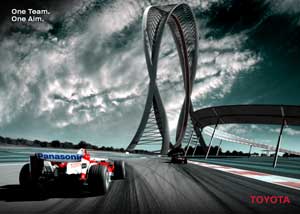JANUARY 4, 2008
When theory becomes (virtual) reality

It has long been said that Formula 1 cars produce so much downforce that they can run upside-down on the ceiling. It is a nice idea but to date no-one had tried it. Getting an F1 car upside-down at the speed needed to achieve such a feat is not going to be something that could be achieved on a small scale and no-one has yet been mad enough to build the kind of structure needed. But that does not stop the imagination. Toyota marketing people understand that the "urban myth" of the upside-down F1 car is a thing of value to underline not just the technology of the sport but also the glamour and the daredevil image that F1 can offer. They have gone to computer experts and asked for animations to show what is possible and have produced new television and static advertisement to show F1 cars looping the loop. To make this all the more attractive to boy racers around the world, the advertising team have used a system that looks a lot like the old Hot Wheels loops that featured in many a racing childhood. Scientifically-speaking it is all entirely possible: at around 100 mph a Formula 1 car will produce around 1000 kg of downforce from its wings, underbody and bodywork. The car with the driver on board weighs 605 kg. Thus, while the weight pushes the car downwards because of the laws of gravity, the 1000 kg of lift (upturned downforce) would overcome that 600 kg and thus pin the car to the ceiling.